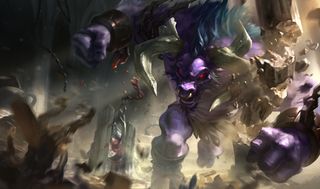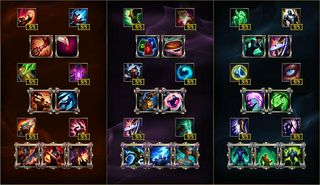Mastering your new League of Legends masteries

Preseason's here! And that means utter, utter chaos. League of Legends' yearly rebalancing period, coming upon the tail of its competitive season, is intended to address some of the more fundamental problems facing the game, specifically issues that would've been too disruptive to address during the regular season (though the top lane itemization overhaul tread dangerously close to these grounds).
5.22's patch notes alone count for a novella, so breaking down the consequences of each and every change'll likely take even longer. But there are definitely two particularly significant categories addressed: the wholesale Marksman update, which adds a whole bevy of new items to the game, and the masteries rework.
Riot didn't just tweak the numbers on the masteries system—they went and did a total system overhaul. Though a few classics still persist (the Total Biscuit of Rejuvenation lives on with but a single click of Secret Stash, even as mana potions are outright removed), the reboot has both streamlined the process of selecting masteries while also making the specific choices you make all that much more important to your in-game conduct and capabilities.
The best way to think of it is that they've changed it from a role-oriented approach, where you pump points into whatever talent tree best serves your role as DPS, tank, jungler, or support, into a style-oriented approach, where before you put a single point in, you're encouraged to consider what best fits the way you play: whether you want to slug it out in an extended brawl, ghost in and out in a fight to assassinate key targets, roam across the entire map to secure objectives and assist teammates, and so on. And to determine that, you first have to consider what Keystone you want.

Setting a Foundation
At first glance, the mastery trees seem to share much of the thematic elements of their counterparts. Ferocity is basically Offense, as most of the damage amplifying masteries are found in it. Resolve, similarly, is basically the Defense tree—armor, health, and health regeneration make up the bulk of its offerings. But not only is the Utility tree greatly changed in its transition into Cunning, the actual merits of each tree is redefined not by how many points you shove into them, but which Keystone mastery you pick from each.
Under the old Offense tree, Havoc was the last mastery you could pick up, and all it did was give a flat 3% bonus to your damage. Defense's Legendary Guardian gave you 3 armor and magic resistance per nearby enemy—more dynamic, but also the only option for that tree. Now, you have a choice of one out of three 'ultimate' masteries per tree. Rather than a flat bonus, it now encourages specific play styles.
Ferocity
- Warlord's Bloodlust: Critical strikes heal you for 5% of the damage dealt, and increase attack speed by 20%.
- Fervor of Battle: Basic attacks and spells grant a stack of Fervor for 5 seconds, and each stack adds bonus physical damage to autoattacks.
- Deathfire Touch: Damaging abilities add burn damage scaling with ability power and bonus attack damage.
Warlord's Bloodlust is currently too powerful overall: its critical heals work against minions and neutral monsters as well, making it way too easy for AD carries to stay in the game—Riot's already planning to change this to trigger only on champions. But even under its intended design, this is basically for the all-in aggro players we hate to support—the Fioras, Yasuos, Vaynes and Corkis of the world who use their dashes to get closer to the enemy instead of running to safety. Healing off of the mastery, along with lifesteal, enables them to duel single targets with great efficiency
The biggest gaming news, reviews and hardware deals
Keep up to date with the most important stories and the best deals, as picked by the PC Gamer team.
Fervor of Battle, in contrast, rewards patience and stubbornness instead. It encourages patient sieges, like the sort you get with Kog'maw, Caitlyn or Jinx—you sit at the peripheries of a fight, far away from the center of the action, and just rain a constant stream of bullets onto the front line. It's an especially potent contribution to siege compositions that want to avoid fights altogether and just hit turrets, Dragons and Rift Heralds all day, quickly stripping down objectives.
Deathfire Touch, meanwhile, is the odd one out. It's nominally a boon to spellcasters, amplifying the effective ability power and attack damage ratios of spells, but it has direct competitors with the Cunning keystones:
Cunning
- Stormraider's Surge: Dealing 30% of a champion's max health grants 35% bonus movement speed for 3 seconds.
- Thunderlord's Decree: Every third attack or spell on an enemy champion deals bonus area of effect magic damage around the target.
- Windspeaker's Blessing: Heals and shields are 10% stronger, and increase an ally's armor and magic resistance for 3 seconds.
In effect, Thunderlord's Decree is what Deathfire wants to be, adding bonus damage as well as fundamentally changing spell effects to make them more dangerous in fights. The area of effect bonus makes it much more dangerous for enemy teams to cluster up, and tacitly encourages them to diffuse their capability to focus-fire on priority targets. Stormraider's Surge, meanwhile, gives assassins what they really want: not extra damage, which they already have plenty of, but a more assured escape route for after they've dropped their payload.
Meanwhile, Windspeaker's the odd one out this time, though not for the same reason. As Ferocity is basically split between magic-oriented and physical-oriented masteries, Cunning is split between burst-oriented and utility-oriented effects. In the case of its last keystone, it's clearly meant for Soraka, Sona, Janna and other forms of 'selfless' supports—a sharp contrast to the kill-seeking specializations of the two others.
Resolve
- Grasp of the Undying: Every four seconds, your next attack steals 4% of an enemy's max health.
- Strength of the Ages: Siege minions and monsters that you or an ally kills grants stacks of permanent health up to 300 HP, then heals you for 100 HP afterward.
- Bond of Stone: Damage is reduced, and you intercept 8% of the damage given to nearby allied champions.
If you're Alistar and not using Bond of Stone, you're really doing it wrong—the potential 78% raw damage reduction with Alistar's ultimate, not to mention absorbing everybody else's damage, almost makes it pointless to attack him at all. Similarly, Bond of Stone makes me want to try out Maokai support to see if his post-6 game is similarly powerful with its effects. Tanky supports and top laners should absolutely grab this—it's basically all they've ever wanted and more.
Meanwhile, there are two kinds of junglers: ambushers, like a level 2 red buffed Jarvan IV, grabbing Grasp of the Undying so that their ganks hit like a truck. Or farm junglers like a Devourer Warwick, using Strength of the Ages to make themselves effectively too bulky to take down as they initiate mid- and late-game fights.
Finishing Touches
Unlike the previous mastery system, once you've pumped 18 points into a tree and picked a keystone, that's pretty much it for that tree. Formerly, there'd be 30-0-0 max damage builds, or 0-30-0 tanks (never 0-0-30, as Utility didn't offer any combat stats back then), but now you're forced to diversify, and that's where it gets tricky.
While the other tiers don't have effects as similarly game-changing as the keystones, they're not without consequences too. It's easy enough for tanky supports to decide to go 0-12-18, for example: 18 points for Bond of Stone, while 12 points into Cunning unlocks Bandit for them, enabling extra gold when an ally kills a minion or when the support attacks an enemy champion. But a mid-lane assassin with Stormraider's Surge has to decide whether to pump all remaining 12 points into Ferocity for Oppressor, dealing bonus damage to crowd controlled targets, or split 6 off into Resolve to get Explorer, which lets them roam through bushes and the river faster for better ganks and getaways.
There's a paradox with the new mastery system: despite reducing masteries from as much as 20 options per tree to just 13 (57 in Season 4 vs. 39 now), there's actually a lot more customization choices—at least, a lot more meaningful choices. Flat statistic bonuses make for cookie-cutter builds, punishing players for stepping out of line from what's optimal. Situationally-triggered effects, on the other hand, reward creativity, putting emphasis on decisions made instead of flat numbers. League of Legends is all the healthier for the new system, and its competitive effects after fine-tuning will hopefully make for even better champion and strategic diversity in the coming year.

PC Gamer Pro is dedicated to esports and competitive gaming. Check back every day for exciting, fun and informative articles about League of Legends, Dota 2, Hearthstone, CS:GO and more. GL HF!
Most Popular

